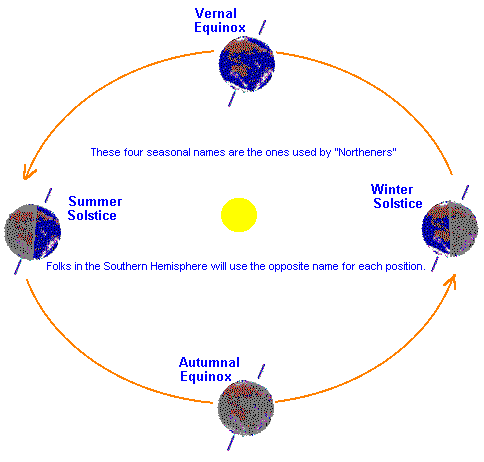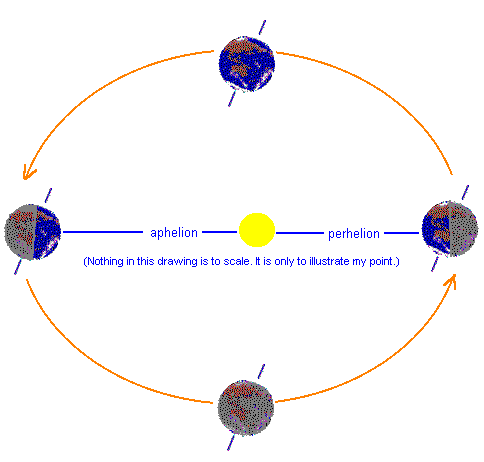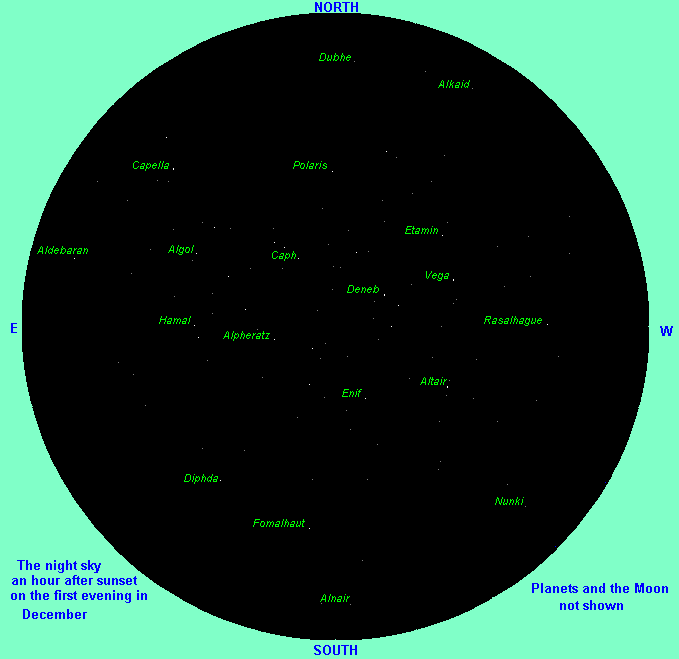|
This month we have a solstice and a couple meteor showers - so let's get into the details!
The "Winter" Solstice occurs around December 21st. Solstice is the day of the year when there is maximum daylight at one hemisphere and minimum daylight at the other. Solstice occurs twice a year. The day of the year midway between the two Solstices is called the Equinox and on that day all parts of the Earth experience equal amounts of daylight and nighttime (12 hours of each). There are two Equinoxes each year.
The time of minimum sunlight for a hemisphere is called the Winter Solstice. For folks
in the Northern Hemisphere it occurs around December 22nd but for folks in the Southern Hemisphere the Winter Solstice occurs six months later around June 21st.
As the earth moves from Winter Solstice to Summer Solstice the days (daylight) grow longer and the Sun rises higher in the noon sky. |  |
Eventually the daytime is equal to the nighttime and we experience the Spring (or "vernal") Equinox. As the Earth continues in its orbit the daylight gets longer and longer as the Sun climbs higher in the sky each noon until it reaches the Summer Solstice. After the Summer Solstice the day length starts to slowly decrease. Three months later (or six months after the Spring Equinox) the Earth's tilt is again perpendicular to the Sun's rays and we have the Autumnal (or "fall") Equinox.
As you can see, the seasonal names of the two Equinoxes and Solstices depend on
which hemisphere you are in at the time.
On the 22nd or 23rd of September (the exact day depends on Leap Years)
the Earth will be positioned so that the Sun's rays strike it
evenly and there will be equal amounts of daylight and nighttime everywhere - both north and south. People in
the Northern Hemisphere will be moving from summer to winter so
they have an Autumnal Equinox but folks living in the Southern
Hemisphere have everything reversed - they are moving from Winter
towards Summer, so they have the Spring Equinox. It's the same
Equinox on the same day (22nd or 23rd of September) but we name it differently
depending upon where we live. After that day those of us in the North
Hemisphere can expect the days to continue to get shorter than the nights as we
move towards winter while the folks in the Southern Hemisphere
will notice that the days continue getting longer than their nights as summer approaches
them.
So, it is the tilt of the Earth that defines our seasons. Some people mistakenly believe that the cold winter days are caused by the distance of the Earth from the Sun. Nothing could be farther from the truth. Indeed, you may be surprised to know that the Earth is closest to the Sun in January!
|
Notice that on the left side of this image the Earth's North Pole is closer to the Sun than the South Pole and vice-versa on the right side. But that difference is very, very small compared to other orbital properties, especially perihelion and aphelion.
Once each orbital period, a planet reaches aphelion, a point in its orbit when it is at its furthest from the Sun. ("Ap" means "far" and "helion" refers to the Sun.) Half an orbital period later (half that planet's "year") we find that planet at its closest approach to the Sun - a position in its orbit called perihelion. There is a difference of about 2.5 million kilometers between the Earth's aphelion and its perihelion. The Earth is only 12,750 kilometers from pole to pole (not at all to scale on this drawing). So you can see that if distance from the Sun was important than we should have extremely cold weather at aphelion and very hot weather as perihelion because the perihelion/aphelion difference is about a thousand times greater than the difference between the two poles. |  |
That doesn't happen. Indeed, the Earth's aphelion occurs in July so, if distance was important, the entire planet should have winter in July.
It's the angle of the Sun in the sky and how long it stays in the sky (per daily rotation) that causes our seasons. On the right side of this image we see the Earth during its Northern Hemisphere winter. It is winter in the North because the Sun spends less time shining on the Northern Hemisphere and does so from a steep angle to the Earth's northern surface. It is this angle that causes the seasonal variations in temperature.
This makes sense for two reasons, both of which you can experience first hand.
If you want to get warmed by the Sun you should stand in the sunlight for as long as you can.
Also, you should try to get the Sun's rays to strike your body perpendicularly on as much of your surface as possible.
Both of these events occur to the Northern Hemisphere on the left side of my drawing - and to the Southern Hemisphere (a half year later) on the right side of my drawing. Meanwhile, the opposite properties (shorter day lengths and bad angle to the Sun) occur on the opposite hemisphere.
December 22nd is the longest night for astronomers in the north and they will have the best views while it is the shortest night for astronomers south of the equator.
If you live in the Northern Hemisphere, bundle up and get outside and enjoy this special night. There's plenty to see. Including meteors!
The Geminids meteor shower starts on December 7th, peaks on the
night of the 13th and are all over by December 16th. This is a
usually a very rich meteor shower with up to 75 meteors seen per
hour during the peak! These meteors are the "offspring" of an asteroid
called Phaethon. Most meteor showers are caused by comets but
there probably isn't a big difference between asteroids and comets
anyway.
The Ursids start just as the Geminids end (on the 17th of December).
Don't get too excited about the Ursids. At their peak on December
23rd you might expect to see only 5 meteors an hour. However,
there have been some years (1945 and 1986) when the Ursids were
surprisingly rich, so have a look just in case this is a good
year. Comet Tuttle is the parent of this shower.
|
Your sky map for the month of DecemberHere's a map of the clear, night sky as seen from the center of the USA on the first evening of this month, an hour after sunset. Specifically, this is the view of a clear sky from a latitude of 37N. Star-gazers farther north, such as in Minneapolis, Chicago and most of Europe, will have more of the northern sky visible and the southern sky will be obscured by the horizon. Vice versa for those who are farther south. The stars will not change position relative to each other, however, throughout the month, the Moon and planets will wander, so they are not shown. Only objects of magnitude 4.0 and brighter are displayed. Here's a reverse color image of the map that will be easier on your printer. |  |
On the night of December 23rd 1672, Giovanni Cassini discovered Saturn's moon Rhea.
In 1845 on the night of December 18th, Hencke discovered the asteroid Astraea.
Francis Pease used the interferometer at the Mount Wilson observatory to make the first measurements of a star's diameter (other than the Sun's) on the night of December 13th 1920.
On December 24th 1968 Frank Borman, James A. Lovell Jr., and William A. Anders became the first humans to orbit another world - the Moon! The Apollo 8 Module took 20 hours to complete 10 orbits (two elliptical orbits but the other eight in nearly circular orbits about 36 kilometers above the surface) and then returned safely to the home world.
On December 15th 1970 the USSR's Venera 7 became the first spacecraft to successfully soft land on another planet - Venus.
On December 3rd 1971 the USSR's Mars 3 became the first spacecraft to make a soft landing on Mars.
Manned exploration of the Moon ended at 22:54:37 UT on December 14 1972, when Apollo 17 Commander Eugene A. Cernan and Lunar Module Pilot Harrison H. Schmitt lifted off from the Moon.
The US's Pioneer 10 flew past Jupiter on December 3rd 1973 and about a year later Pioneer 11 followed.
I hope you found the Night Sky this Month to be helpful and educational. I invite you to return here monthly for new information.